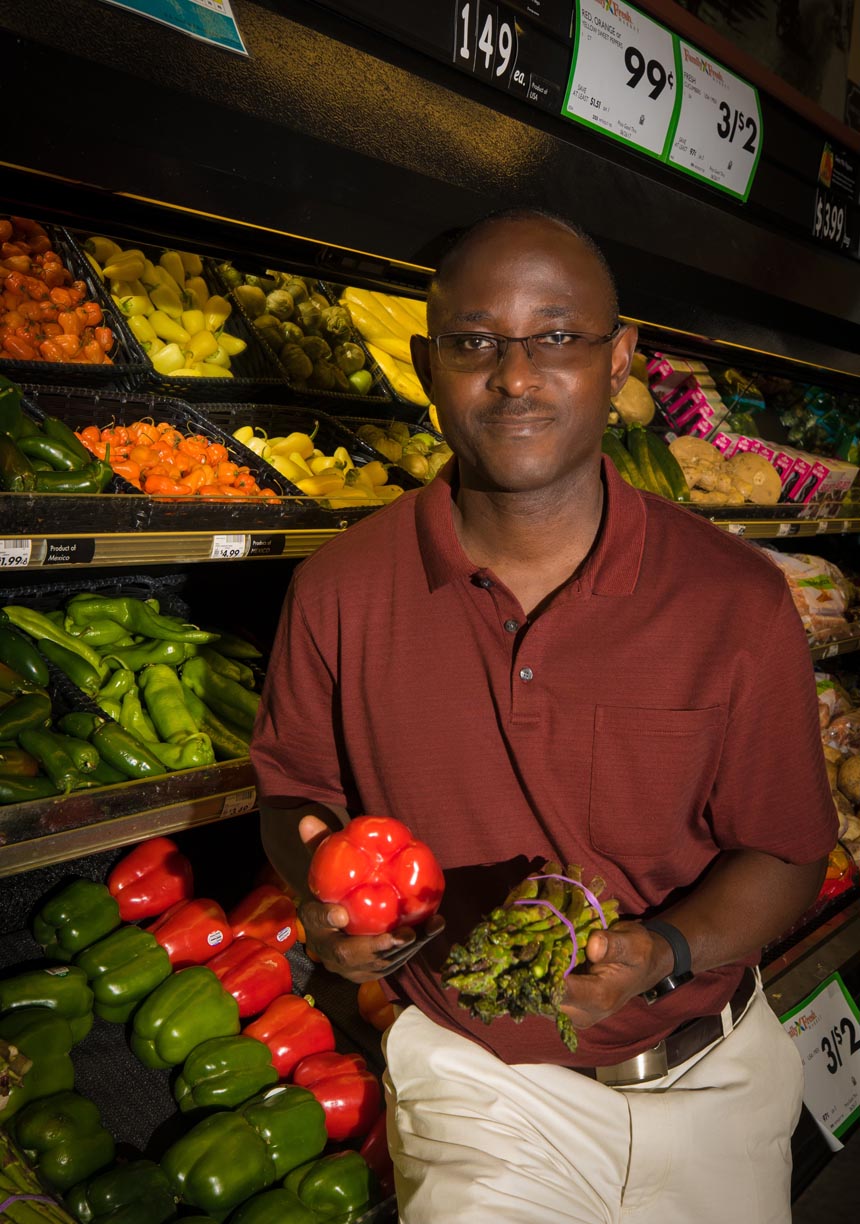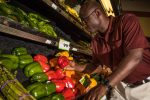Frank Tenkorang was still a graduate assistant at Purdue University when his officemate mentioned some exciting news: the school had started powering its trucks with soy biodiesel.
It was 2005, and the United States was jumping on the biofuels bandwagon.
In the years since, Tenkorang has seen biofuels – corn-based ethanol in particular – evolve from a budding industry into an established part of the Midwest economy, and now into a controversial commodity with a future that’s up for debate with the current administration. Federal support ended in 2011, and there’s strong opposition to further subsidies.
“There were about billion in tax credit and import tariffs to protect the ethanol industry. It was then young, and it is cheap to produce ethanol in Brazil, so we had to protect the domestic producers. And there was also a blender’s subsidy, for those who blended ethanol with gasoline to reduce their cost. They have all been taken away,” Tenkorang said.
Biofuels are produced from living matter, unlike fossil fuels that use non-renewable resources. A Renewable Fuels Standard, passed by Congress in 2005 and expanded in 2007, requires that the transportation fuel sold in the U.S. include up to 36 billion gallons of biofuel by 2022. While the U.S. is using and producing more ethanol than ever, Tenkorang said the product’s reputation and chances for future government support are hurt by critics who think ethanol takes too many acres of corn away from food production.
“Those of us in the Midwest … we think that ethanol is good because it helps in job creation, supports prices for farmers, also energy independence, but there are many countries out there painting a very negative picture for ethanol,” Tenkorang said. “And one of the main reasons we’re seeing a decrease in government support is because of the effect on food prices. And this is not just in the U.S., but it is a global effect. Most developing countries are complaining about U.S. ethanol and high food prices.”
Believing that ethanol production creates higher food prices and food shortages, policy makers are pushing for “second-generation ethanol,” made from materials such as wood chips and algae rather than corn. But Tenkorang said people may be turning away from the corn-based fuel too quickly. His research has shown that ethanol production wasn’t to blame for the doubling of food prices since 2000.
“There was a correlation” between increasing ethanol production and increasing food prices, he said, “but not causation.”
A professor and chair of the economics department at the University of Nebraska at Kearney, Tenkorang has studied the economic effects of ethanol for almost a decade. He’s looked at how ethanol production affects other crops, consumer decisions related to ethanol, and the fuel’s impact on corn prices.
A paper accepted by the Agricultural Economics Review outlines his findings on ethanol and food prices. In “Ethanol Production and Food Price: Simultaneous Estimation of Food Demand and Supply,” Tenkorang and co-author Bree Dority O’Callaghan used data from 1980-2014 to create food demand and supply estimates. They found that the huge increase in ethanol production by Brazil and the United States didn’t have a statistically significant impact on world food prices. In fact, if producing more ethanol can bring down energy prices, the alternative fuel could help lower food prices.
“One thing we see now is very low energy prices. Oil prices are down, and one of the things we found in that study is that one of the big factors influencing food price was energy price, not ethanol.”
Tenkorang hopes the article will appear in the journal later this year, and that its findings can help influence policy makers toward investing in ethanol.
“It looks as if the current administration wouldn’t mind promoting ethanol, but the current ag secretary (Sonny Perdue), before he became ag secretary, strongly opposed ethanol. We really can’t tell what’s going to happen with policy,” Tenkorang said.
Tenkorang’s research focus on ethanol was a product of timing and location. A native of Ghana, he came to the United States to attend the University of Wyoming. By the time he received his doctorate from Purdue in 2006, the U.S. produced 4.9 billion gallons per year, according to the Renewable Fuels Administration. That number grew to 13.9 billion gallons by 2011.
Demand was high for economists to analyze the effects of the booming industry. Tenkorang’s first interview was at a research institute keen on research about how ethanol would affect commodity prices. During his visit, he saw another school announcing a job search for an energy economist to work on ethanol.
Once at Kearney, Tenkorang found himself in the middle of corn country – the perfect place for research on ethanol. He has since written several journal articles and presented at numerous conferences about the subject, as well as writing an article titled “Nebraska, Sprinkled with Corn and Ethanol” for the 2015 encyclopedia Just Plain Folks: Studies of the People of the Great Plains. His work – with UNK economics professor Debbie Bridges – spans the expansion years for U.S. ethanol, through a production dip after 2011, to the current growth period that’s seen production rise to 15.3 billion gallons, 1 billion of which is exported.
 ETHANOL, GASOLINE RELATIONSHIP
ETHANOL, GASOLINE RELATIONSHIP
While it’s promising to see the ethanol industry grow with less government support, the question now is how to keep the industry expanding.
In a 2015 study published in Energy Economics, Tenkorang looked at the relationship between ethanol and gasoline. Analyzing data on fuel consumption, he found that today’s drivers consider ethanol a complement to regular gasoline, rather than a substitute. That attitude suggests that usage won’t increase by trying to convince more consumers to choose ethanol. Producers may be better off trying to increase the percentage of ethanol that’s blended with gasoline.
“We’ve gotten to a point that we can’t increase consumption of ethanol without consumption of gasoline. With that, if we are going to see an increase in production, how are we going to use that increased production? We may have to switch from E10 to E15, or maybe E20 or 25,” Tenkorang said.
And that is where federal subsidies could be useful.
“That’s also a concern because most gas pumps cannot handle a high percentage of ethanol, so the gas stations may have to change their pumps, and that requires money,” he said.
Other key studies Tenkorang has done showed that increased ethanol production has decreased Nebraska hay production, and created greater variability for corn and soybean prices.
Tenkorang’s long-term interest in ethanol issues has also led University of Nebraska-Lincoln professors to include him and other UNK faculty in an upcoming project that will take a more comprehensive look at agricultural and ecological issues. The research depends on the success of a 2016 grant proposal submitted to the University of Nebraska System Science Collaboration Initiative, which Tenkorang describes as FEW – Food, Energy and Water.
“What we want to do is look at the three components together, rather than looking at them separately,” Tenkorang said, to get a comprehensive view of how the three influence each other – how the production of food and energy affect each other, and how they affect water supply and quality. Tenkorang said they’ll begin by gathering data within Nebraska.
“We want to understand it here, then apply for a bigger grant that will allow us to look at it on either a national or a global scale,” he said.
CONSUMER ATTITUDES
So far, Tenkorang’s research has used existing data, analyzed using various equations to control for relevant variables. Collecting and working with his own data has been Tenkorang’s goal for years, though, and he’ll do that in an upcoming project with Fletcher Ziwoya of UNK’s department of communication.
Their pending grant application would fund a study on consumer attitudes toward ethanol, with the goal of determining what influences the way people feel about the alternative fuel.
“These days it’s all ‘Well ethanol is not good, it requires too much energy.’ Others claim it has negative impact on food prices, causing food prices to increase. Is this real, or is this just how people feel?”
By surveying participants about their backgrounds and lifestyles, he hopes to find a relationship between their ethanol attitudes and some other factors. For example, Tenkorang said, he would expect people from Nebraska and Iowa to have more favorable ideas about ethanol than people from California.
“We want to inform policy makers … whether the approval or disapproval of ethanol is just based on feelings, or emotional, or is it something realistic, or scientific. That’s what we want to inform policy makers about so they can make informed decisions,” he said.
Already, Tenkorang knows just how much Americans’ attitudes toward the fuel have changed, as ethanol has become a part of their daily lives.
“What I see, first of all, I think we are beginning to accept it. Initially we thought it was going to break down our vehicles, and I think that fear is gone. We don’t have that fear any more. The concern that people have, and again most often outside the corn-producing areas and in other countries, is that it still has an impact on food prices. They hold onto that belief strongly, that it has impact on food price, and they just don’t like it.”
And that’s an attitude Tenkorang hopes he’ll soon see changing.
“I’m hoping that what we see now, of the low commodity price, more ethanol production, low energy price, people will begin to connect the dots themselves.”
 FRANK TENKORANG
FRANK TENKORANG
Title: Professor and Chair, Economics
College: Business and Technology
Education: Bachelor of Science, Agriculture, University of Ghana, 1996; Master of Science, Agricultural Economics, University of Wyoming, 2002; Ph.D., Agricultural Economics, Purdue University, 2006.
Years at UNK: 10
Career: Research Assistant, Institute of Statistical, Social, and Economic Research, University of Ghana; Graduate Research Assistant, University of Wyoming; Graduate Research Assistant, Purdue University.
Family: Children, Nana Ama, 15, and Kojo, 11.
Hobbies/Interests: Racquet sports, tennis
Areas of research/specialization: Agricultural issues, specifically the impact of ethanol production on commodity markets.
Courses taught: Principles of Microeconomics, Intermediate Microeconomics, Managerial Economics, Agricultural Marketing, Economics of the Agricultural Sector, Farm and Ranch Management, Agricultural Price Analysis.
Professional Membership and Service: Agricultural and Applied Economics Association, 2005-present; Reviewer, Journal Article, Energy Policy, 2016; Reviewer, Journal Article, Energy Strategy Reviews, 2017; Reviewer, Journal Article, UNK Office of Undergraduate Research, 2015; Session Chair, American Society of Business and Behavioral Sciences Program of the 22nd Annual Conference, Las Vegas, 2015; Reviewer, Journal Article, National Mountain Plains Management Conference, 2010.
UNK Committees: CBT: BD Assurance of Learning Committee, 2010-13; Nebraska Bankers Association Scholarship Review Team, 2011-13; Business Division Assessment Council, 2010; CBT: BD Assurance of Learning Committee, 2009-10; International Studies Advisory Council, 2009; World Affairs Conference, 2009; John Becker Endowed Professorship, 2009; Writing Intensive/Cultural Diversity Committee, 2009; CBT: Business Division Assurance of Learning Committee, 2008-09; CBT Deans Advisory Committee, 2006-08.
Recent Published Articles:
- “Hemp Adds to the Profitability of Corn Soybean Rotation,” In The Return of an Ancient Partner, 2016.
- “Hedonic Price Analysis of Non-Barren Broodmares,” Review of Economic and Business Studies, 2016.
- “Relationship Between Ethanol and Gasoline: AIDS Approach,” Energy Economics, 2015.
- “Implications of Increased Ethanol Production on Nebraska Hay Production: An Initial Investigation,” Economics and Business: Inquiries and Perspectives, 2015.
- “Nebraska, Sprinkled With Corn and Ethanol,” Just Plains Folks: Studies of the People of the Great Plains Folks, 2015.
-30-













